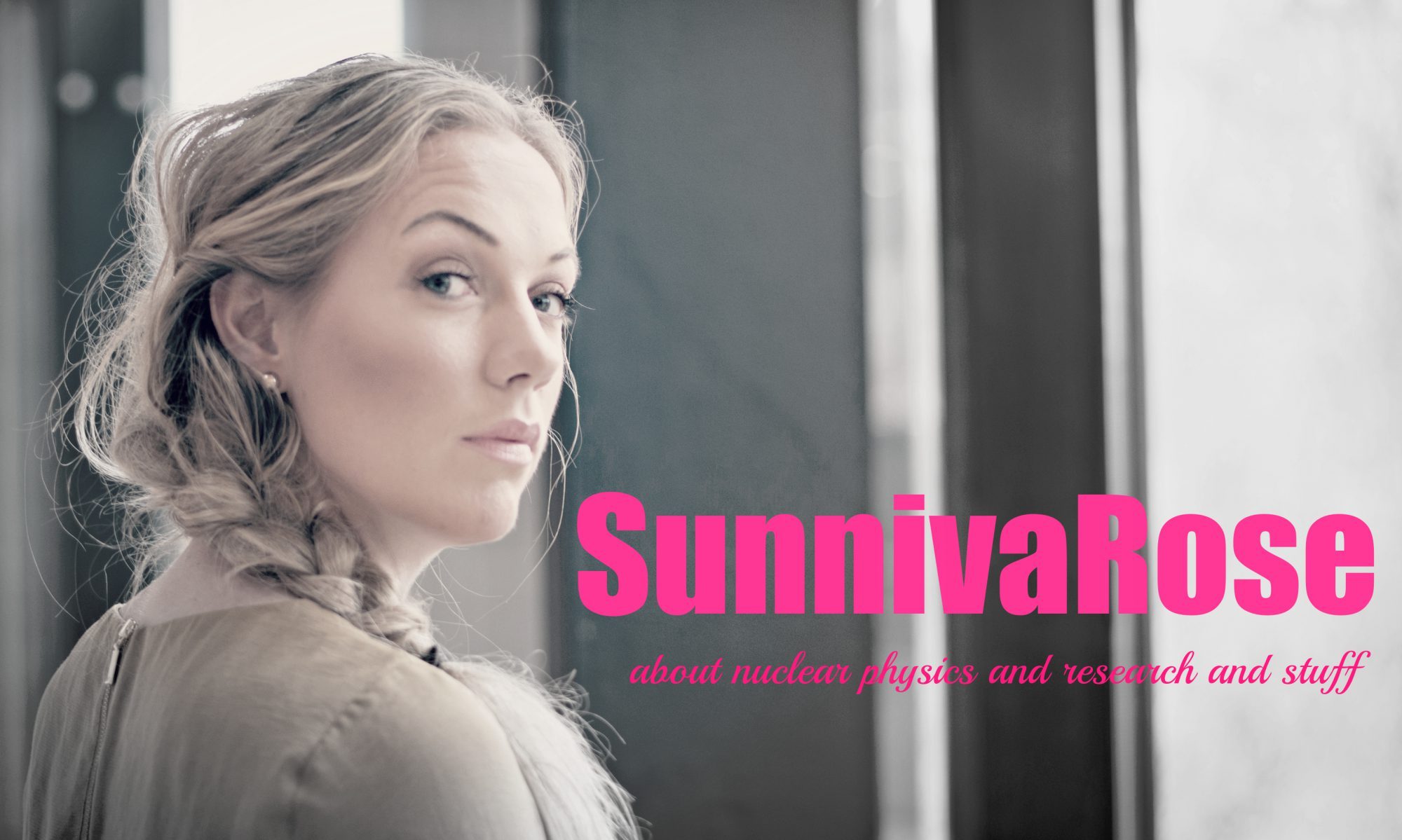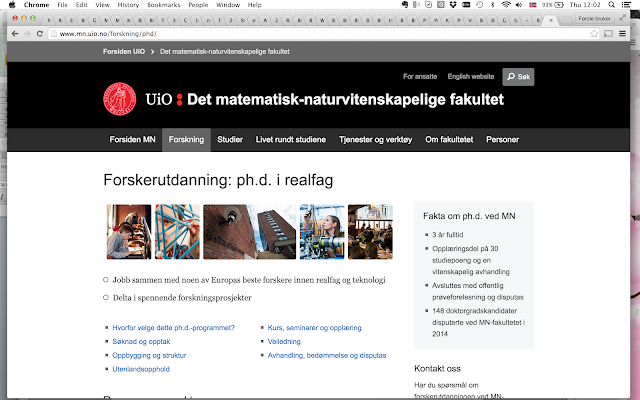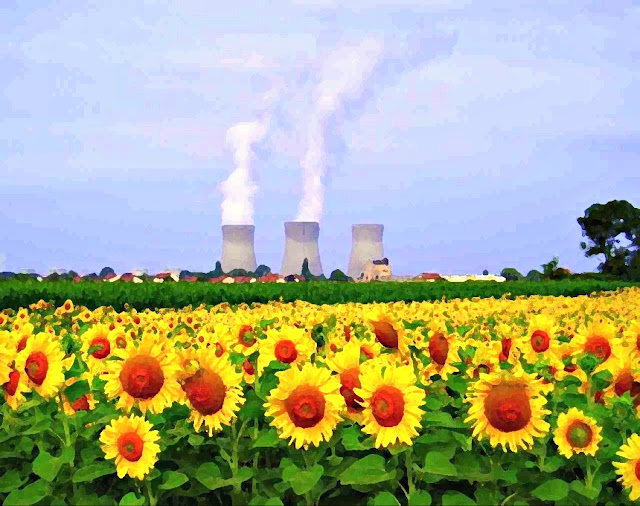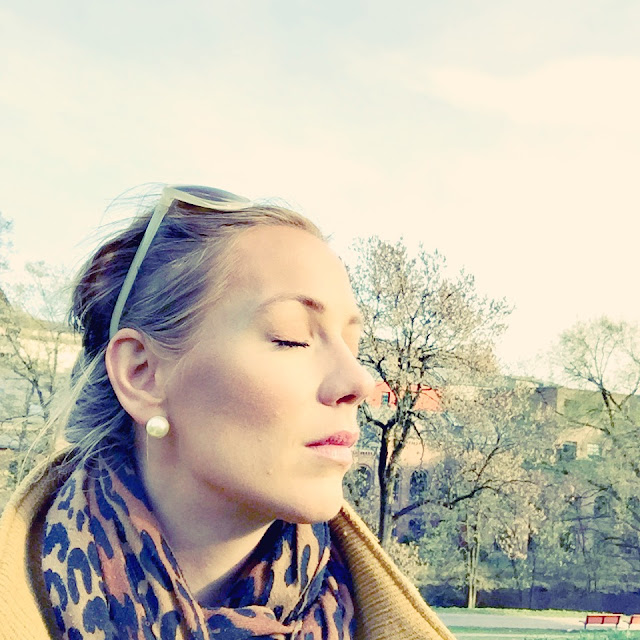10 facts about nuclear physcis
- nuclear physics is all about the atomic nucleus - discovered by accident by Ernest Rutherford a century ago, when he was bombarding a thin gold foil with alpha particles
- there's so much we don't know about the heart of the atom - the nucleus; and that's why we are a lot of people around the world still spending all of our lives to study it, and try to understand the nucleus and the nuclear force that holds it all together (how does it really work, and why, and how big can a nucleus actually get?)
- all atoms have a nucleus - nuclear physics is as much about the non-radioactive nuclei (stable gold, stable oxygen, stable iron), as the radioactive ones (thorium, uranium, plutonium)
- the "applied part" of my phd thesis is about nuclear power, which is of course also one part of nuclear physics - how to produce energy from big nuclei that splits in two (you get heat and you can boil water and you get steam and then you can generate electricity)
- I don't want to lie; atomic bombs is also something that some people (not in Norway) study - knowledge about nuclear physics can be used in such a destructive way. As can most knowledge if I think of it...
- knowledge about nuclear physics tells us about the creation of the elements - what happens in the sun and similar stars; how do they get their energy, and what happens there? In stars like our sun, elements all the way up to iron are produced
- no elements that are heavier than iron can be produced in stars/the sun, but we know they exist so they must have been created somehow (we know gold exist, we know thorium exist, we know there is lead - to give some examples), but not where they came from. Creation of these heavy elements is actually one of the great mysteries, and we think they are made in explosions or collisions in space. We use nuclear physics to try to figure out how and where all these elements are created.
- one of the really nice applications of nuclear physics is radiation therapy. Atomic radiation may cause cancer, but it may also cure cancer <3
- if you've ever had a CT scan, you've experienced applied nuclear physics. Think about it: it's kind of awesome that we can actually look inside the body, and get really great images of the inside, without even cutting it open...!
- PET, which is short for positron electron tomography is another imaging technique in the nuclear medicine, where you actually detect gamma radiation from an electron that meets its anti particle, the positron (awesome, seriously!). And from this you can create beautiful three dimensional images of for example a tumour inside the body
Sunniva recommends: Pandora's Promise
Watch it.
And Robert Stone, you get three hearts: <3<3<3
The entire thing is on Netflix.
Thursday blues
- bad conscience (I spend too little time on my degree, and too much time procrastinating)
- procrastinating
- writing for an hour as I feel bad (my conscience bugging me since I procrastinated when I got to the University, instead of writing)
- searching the University's web pages for a template for my thesis - turns out it doesn't seem to exist (help?!), but I found myself as poster-girl on the frontpage of the phd education. Lol.
- going to the MNKOM lunch talk, to listen to all the science communication students (as I was also making some notes from an article #multitasking)
- finding a template for master's thesises - works for now
- starting cleaning up and putting stuff I've written before into the template - looking kind of good
- writing a short introduction to my articles (that the thesis will be based on)
- thinking I know which order to put things in my thesis (which is supposed to sew the different articles together)...I've changed my mind several times, tough, so who knows what I'll end up with
Too fun!
 |
|
Alex getting her nails done (pink nail polish and a gold diamond - her choice) at Star Nails, Grønland Basar. Just 50,- for kids, which I think is a nice prize 🙂
|
When can we say that a nuclear power plant is safe?
"Is it possible to conclude that a nuclear power plant is safe and, if it is, what are the conditions which make this conclusion possible?
The answer to the first question is: 'Yes, it is possible'.
The conditions for such a conclusion to be valid are:
- the plant has been built within a legal framework that provides for the regulation of nuclear activities and for the clear assignment of safety responsibilities
- the plant site has been chosen by a competent organization, following the stringent safety and radiation protection criteria internationally available
- the plant has been conceived, designed and built following the best internationally available criteria and standards important for safety and for radiation protection (with all financial means necessary to obtain an excellent result)
- the whole process has been submitted to the surveillance of an independent control body, capable (as far as possible) of foreseeing the possible technical licensing problems before it's too late to solve them
- everyone involved in the construction, the control and the operation of the plant are permeated by a genuine safety culture
- everyone involved have been trained to the best professional standards with continuing professional development schemes
- operation is performed in connection with national and international organizations which have the aim of collecting and disseminating operating experience thoroughly and quickly
- the plant is operated within an industrial system with a sufficient reserve of electric power
- working conditions for plant operators are conducive to solving problems, and the psychological atmosphere in the plant is marked by alacrity and by serenity at the same time"
When all of these nine criteria are met (I shortened some of them, so in the original text they are more comprehensive), then you can claim that a nuclear power plant is safe.
Was Chernobyl "safe"? NO, NOT AT ALL! I know for sure that Chernobyl broke the conditions, and definitely could not be concluded to be a "safe" plant.
Was Fukushima "safe"? To be honest, I'm actually not 100% sure of how well Fukushima met these 9 criteria...
The thing about the Fukushima accident was that it was caused by a "freak event" - a natural disaster that magnitude is very hard to foresee, since you can't foresee everything. If you could, none would have died from the earth quake and tsunami that hit Japan on the 11th of March 2011, but yet they did - but if you argue that since this natural disaster did happen, and therefore nuclear power isn't safe, you're really also arguing that Japan is an unsafe country to live in...
It's not like they din't foresee tsunamis on the coast of Japan, but they didn't expect them to be as big. So what if they had foreseen a 14 meter tsunami, and they were protected against that, but then a 15 meter tsunami hit them instead? Nothing is ever (100%) safe, and at some point you have to say this is as safe as it gets. Remember: it's always a piece of cake to say after something's happened that they should have done it differently...!
But was Fukushima as safe as it gets? Maybe not. Maybe the plant site (point 2) wasn't 100% ideal, maybe the plant didn't have sufficient reserve of electric power (point 8). Can we then conclude that nuclear power isn't safe at all? No.
Have a fabulous, sunny day everyone! I'm going to get Alexandra in kindergarden very soon, and then we're going to get our nails done #motherdaughtertime <3
Monday
meetings, yes - plural
Today's office
Here are two pictures of me thinking and drinking coffee and taking selfies instead of actually writing anything...:P (Love this maritime looking sweater from Pimkie, by the way <3)




























